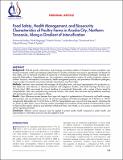| dc.description.abstract | Background: With the growth, urbanisation, and changing consumption patterns of Tanzania’s human population, new
livestock production systems are emerging. Intensification of poultry production may result in opportunities and threats for
food safety, such as improved awareness of biosecurity or increasing prevalence of foodborne pathogens including non-
typhoidal Salmonella or Campylobacter spp. We conducted a semiquantitative analysis of poultry production systems in
northern Tanzania, with emphasis on biosecurity, health management practices, and prevalence of foodborne pathogens,
to gain insight into potential associations between intensification and food safety.
Methods: Interviews were conducted with managers of 40 poultry farms, with equal representation of 4 production sys-
tems (extensive, semi-intensive, or intensive production with indigenous chickens, and broiler farming). Per farm, up to
10 birds (total, 386) were tested for cloacal shedding of nontyphoidal Salmonella, with a subset of farms tested for
Campylobacter. Data were analysed using univariate statistics, and results were discussed during feedback workshops
with participating farmers and extension officers.
Results: Clear differences existed between farm types with regard to implementation of biosecurity and health manage-
ment practices and use of extension services. By contrast, prevalence of foodborne pathogens (6 of 40 farms or 15% for
nontyphoidal Salmonella and 13 of 26 farms or 50% for Campylobacter spp.) was not farm-type specific, indicating that
it is driven by other factors. Across farming systems, knowledge and awareness of the presence of antimicrobials in poul-
try feed and the need to abide by post-treatment withdrawal times were limited, as was access to impartial professional
advice regarding treatment.
Conclusion: Different control measures may be needed to protect poultry health compared to public health, and
improvements in information provision may be needed for both. | en_US |

